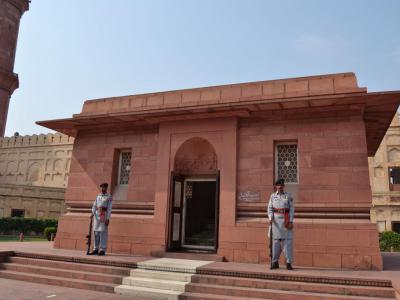
Tomb of Allama Iqbal, Lahore
The Tomb of Allama Iqbal serves as the final resting place of Muhammad Iqbal, the national poet of Pakistan. Designed in the distinctive Mughal architectural style, this mausoleum is situated adjacent to the magnificent walls of the historic Badshahi Mosque within the enchanting Hazuri Bagh garden.
Muhammad Iqbal, affectionately known as Muffakir-e-Pakistan (The Thinker of Pakistan) and Shair-e-Mashriq (The Poet of the East), was a prominent inspiration behind the Pakistan Movement. He passed away on 21 April 1938 in Lahore at the age of 60, leaving an indelible mark on the nation's history and identity. The Tomb of Allama Iqbal has since become a place of pilgrimage for thousands of visitors who come daily to pay their respects to the poet-philosopher.
The architectural style of the mausoleum is a harmonious blend of various influences, primarily reflecting the grandeur of Mughal architecture. Constructed entirely from red sandstone, which was sourced from Jaipur in British India, and adorned with marble from Makrana, Rajputana, the structure boasts a timeless appeal. However, construction faced delays after Pakistan's independence in 1947 due to export restrictions on red stone from India.
Inside the mausoleum, six couplets of a ghazal from Iqbal's poetic work, Zabur-e-Ajam (Persian Psalms), are intricately carved on the interior surfaces, adding to the artistic allure. Outside, a small garden surrounds the tomb, divided into neatly arranged plots. The mausoleum's design was masterminded by Nawab Zain Yar Jang Bahadur, then Chief Architect of Hyderabad Deccan. Its construction spanned thirteen years and cost approximately one hundred thousand Pakistani rupees. The main cause for the delay was the interruption in the supply of red stone from Jaipur, India, following independence.
The rectangular mausoleum features two elaborately designed gates, one at the eastern entrance and the other at the southern side, embellished with marble. The cenotaph itself is sculpted from white marble and stands as a remarkable centerpiece. An exceptional tombstone, gifted by the people of Afghanistan, is crafted from lapis lazuli and intricately inscribed with Quranic verses in elegant calligraphy, a treasure from Afghanistan's cultural heritage.
Muhammad Iqbal, affectionately known as Muffakir-e-Pakistan (The Thinker of Pakistan) and Shair-e-Mashriq (The Poet of the East), was a prominent inspiration behind the Pakistan Movement. He passed away on 21 April 1938 in Lahore at the age of 60, leaving an indelible mark on the nation's history and identity. The Tomb of Allama Iqbal has since become a place of pilgrimage for thousands of visitors who come daily to pay their respects to the poet-philosopher.
The architectural style of the mausoleum is a harmonious blend of various influences, primarily reflecting the grandeur of Mughal architecture. Constructed entirely from red sandstone, which was sourced from Jaipur in British India, and adorned with marble from Makrana, Rajputana, the structure boasts a timeless appeal. However, construction faced delays after Pakistan's independence in 1947 due to export restrictions on red stone from India.
Inside the mausoleum, six couplets of a ghazal from Iqbal's poetic work, Zabur-e-Ajam (Persian Psalms), are intricately carved on the interior surfaces, adding to the artistic allure. Outside, a small garden surrounds the tomb, divided into neatly arranged plots. The mausoleum's design was masterminded by Nawab Zain Yar Jang Bahadur, then Chief Architect of Hyderabad Deccan. Its construction spanned thirteen years and cost approximately one hundred thousand Pakistani rupees. The main cause for the delay was the interruption in the supply of red stone from Jaipur, India, following independence.
The rectangular mausoleum features two elaborately designed gates, one at the eastern entrance and the other at the southern side, embellished with marble. The cenotaph itself is sculpted from white marble and stands as a remarkable centerpiece. An exceptional tombstone, gifted by the people of Afghanistan, is crafted from lapis lazuli and intricately inscribed with Quranic verses in elegant calligraphy, a treasure from Afghanistan's cultural heritage.
Want to visit this sight? Check out these Self-Guided Walking Tours in Lahore. Alternatively, you can download the mobile app "GPSmyCity: Walks in 1K+ Cities" from Apple App Store or Google Play Store. The app turns your mobile device to a personal tour guide and it works offline, so no data plan is needed when traveling abroad.
Tomb of Allama Iqbal on Map












Sight Name: Tomb of Allama Iqbal
Sight Location: Lahore, Pakistan (See walking tours in Lahore)
Sight Type: Attraction/Landmark
Guide(s) Containing This Sight:
Sight Location: Lahore, Pakistan (See walking tours in Lahore)
Sight Type: Attraction/Landmark
Guide(s) Containing This Sight:
Walking Tours in Lahore, Pakistan
Create Your Own Walk in Lahore
Creating your own self-guided walk in Lahore is easy and fun. Choose the city attractions that you want to see and a walk route map will be created just for you. You can even set your hotel as the start point of the walk.
Lahore Introduction Walking Tour
"Lahore Lahore Hai." This popular Punjabi song (translating as "Lahore is Lahore") emphasizes the uniqueness and special character of this city, suggesting that there is no place quite like it. Also known as the "Pearl of the Punjab," Lahore is the second-largest city in Pakistan.
The name "Lahore" itself has a rather intriguing story. Some historians... view more
Tour Duration: 2 Hour(s)
Travel Distance: 2.8 Km or 1.7 Miles
The name "Lahore" itself has a rather intriguing story. Some historians... view more
Tour Duration: 2 Hour(s)
Travel Distance: 2.8 Km or 1.7 Miles

